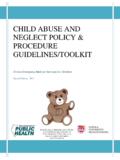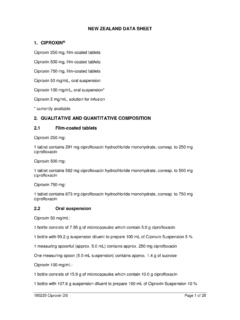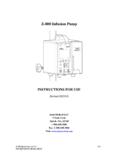Transcription of INTERFACILITY CRITICAL CARE TRANSPORT (CCT) …
1 INTERFACILITY CRITICAL CARE TRANSPORT (CCT) PROTOCOLS FOR ADVANCED MEDICAL TRANSPORT OF CENTRAL ILLINOIS Amiodarone For INTERFACILITY Use Only Usage: Class III antiarrhythmic drug. Indicated for treatment and prophylaxis of frequently recurring ventricluar fibrillation and hemodynamically unstable ventricular tachycardia. It prolongs the duration of action potential and effective refractory period. Noncompetitive alpha and Beta adrenergic inhibition. It increases PR and QT intervals and decreases sinus rate. Adverse Reactions: CV: Hypotension most common, torsades de pointes, sinus arrest, bradycardia, CHF Pulmonary: Pulmonary toxicity, progressive dyspnea, fatigue, cough, pleuritic pain, fever. Contraindications: Known hypersensitivity. Cardiogenic shock, marked sinus bradycardia and 2nd or 3rd degree heart block, severe liver disease.
2 Equipment Use: Amiodarone must be infused via MTP pump. Standing Orders: 1. Amiodarone infusion must be initiated at the transferring hospital. 2. Verify concentration and infusion rate prior to leaving transferring hospital. 3. Assess K+, Mg, liver function, if available. 4. Review medication administration record. If taking a beta blocker or calcium channel blocker, notify Med Comm. (Amiodarone may be used with caution with these medications.) 5. Assess I&O 6. Monitor B/P, heart rate. Notify Med Comm if heart rate less than 60 or B/P less than 90. 7. Rate of infusion should not be changed unless ordered. 8. Amiodarone is incompatible with other drugs. Infuse through a central line if available. Dosages: 1. Loading dose (to be given at the transferring hospital) 2. After loading dose 360 mg over the next 6 hours, 1 mg per minute.
3 3. Maintenance infusion: 540 mg over 18 hours (.05 mg/min.) _____ Personnel Administering Drug - Advanced Medical TRANSPORT of Central Illinois EMT-P, who have successfully completed CRITICAL care training and CRITICAL time, will be monitoring the medication administration. Revised: 11/01 C:\WINDOWS\Desktop\Web graphics\ INTERFACILITY CCT Ativan (Lorazepan) For INTERFACILITY Transfer Only Usage: Sedative, control of seizures, relief of anxiety Complications/Adverse Reactions: Irritation at injection site, hypersensitivity, CNS depression; drowsiness Equipment: May be given IV push at per protocol. Standing Orders: 1. Routine medical/cardiac care 2. Verify orders from transferring hospital 3. Ativan 1-2mg IV push over 2 minutes or as prescribed 4.
4 Watch for respiratory depression. If present, notify base station physician. _____ Personnel Administering Drug - Advanced Medical TRANSPORT of Central Illinois EMT-P, who have successfully completed CRITICAL care training and CRITICAL time, will be monitoring the medication administration. Revised: 11/01 C:\WINDOWS\Desktop\Web graphics\ INTERFACILITY CCT Blood Administration For INTERFACILITY Transfer Only Usage: To replace blood loss while maintaining adequate circulating volume and oxygen TRANSPORT . Complications: Transfusion reactions. Severe reactions are usually manifested during the initial 50cc or less of infusion. Adverse Reactions: Too rapid an infusion producing a volume overloaded state. Incompatible ABO blood administration.
5 Equipment Use: Infusion pumps may be helpful but not required unless delivery is through a central venous catheter or pediatrics. Standing Orders: 1. Initial blood administrations will be instituted at the transferring hospital. 2. Verify the physician order for blood product, blood type, rate of infusion and use of microaggregate or leukocyte removal filter. 3. Assess patient for religious or cultural objections to transfusion, history of previous reaction to a blood product and for pre-transfusion symptoms that could be mistaken for a transfusion reaction. 4. Assess baseline TPR and BP prior to starting transfusion and at least every 15 minutes x 2 after the transfusion is initiated; then hourly while blood is infusing and again when transfusion is completed (except albumin and plasma protein fraction).
6 Vital signs must be documented. 5. Assess TPR and BP every 15 minutes x 4 during intravenous gamma globulin administration. 6. Replace blood tubing after every 2 units or after 4 hours of use. Discard tubings immediately following completion of transfusion. Blood Administration Page 2 Revised: 11/01 C:\WINDOWS\Desktop\Web graphics\ INTERFACILITY CCT 8. Assess for potential signs of transfusion reaction: General Gastrointestinal - Fever (rise > 1 F degree or 2 C degrees) - Nausea, vomiting - Heat or pain at infusion site - Cramping, diarrhea - Chills, diaphoresis Renal - Muscle aches, pain - Decrease in urine output - Back pain, chest pain, headache - Changes in urine color - Rashes, hives, itching (brown or red) - Cool/clammy or hot/flushed skin Cardiovascular Neurologic - Changes in heart rate - Apprehension, sense of doom (bradycardia or tachycardia)
7 - Tingling, numbness - Changes in blood pressure Respiratory (hypotension or hypertension) - Cough, dyspnea - Edema - Rales, wheezing - Onset of bleeding - Changes in respirations Monitor peripheral site and infusion system at least every hour during blood product administration. For any suspected reaction: - Stop transfusion, do not clear tubing - Recheck labels - Notify base station physician - Remove bag and tubings; start isotonic saline - Monitor and treat symptoms - Collect a urine specimen for receiving hospital - Save blood bag - deliver to receiving hospital along with urine specimen for further testings _____ Personnel Administering Drug - Advanced Medical TRANSPORT of Central Illinois EMT-P, who have successfully completed CRITICAL care training and CRITICAL time, will be monitoring the medication administration.
8 Revised: 11/01 C:\WINDOWS\Desktop\Web graphics\ INTERFACILITY CCT Cardizem (diltiazem) For INTERFACILITY Use Only Usage: Atrial fibrillation with rapid ventricular response, atrial flutter, Paroxysmal Supraventricular Tachycardia (PSVT) Complications\Adverse Reactions: CNS dizziness, parasthesias, headache, weakness, visual disturbance. CV: hypotension, facial flushing, junctional or AV dissociation, chest pain, congestive heart failure, ventricular or atrial arrhythmias, edema Demertalogic: injection site reaction (itching, burning), sweating GI: constipation, nausea, vomiting, dry mouth Equipment Maintenance: All Cardizem drips must be administered via an infusion pump and will be initiated at transferring hospital. Standing Orders for Administration by Transferring Facility: Verify concentration, dosage and VS parameters on physician s order sheet from transferring hospital.
9 (Usual dose is 125 mg/ 100 cc NS or D5W or NS; this yields 1 mg/min delivered dose) Monitor vital signs: B/P, heart rate every 15 minutes continuous EKG monitoring. Notify Medical Control of the vital signs (heart rate < 110 / > 150, or Systolic BP <90) deviate from the predetermined parameters set forth by the transferring hospital. Notify Medical Control of any AV block. _____ Personnel Administering Drug - Advanced Medical TRANSPORT of Central Illinois EMT-P, who have successfully completed CRITICAL care training and CRITICAL time, will be monitoring the medication administration. Revised: 11/01 C:\WINDOWS\Desktop\Web graphics\ INTERFACILITY CCT Demerol For INTERFACILITY Transfer Only Usage: Analgesia and sedation may be given as a bolus or via PCA pump.
10 Complications/Adverse Reactions: Respiratory depression, cardiac arrest, most frequently light headedness, dizziness, sedation, nausea, sweating, tachycardia, hypotension. Equipment Use: May be given IV push per protocol. Standing Orders: 1. Verify drug, dose, route of administration. 2. Demerol PCA must be run through a PCA pump. Refer to compatibility chart before pushing Demerol through an infusing IV. If no IV infusing begin D5W or LR KVO. 3. Push IV dose over 1-2 minutes. 4. Monitor VS; if respiratory depression or hypotension occur contact base station physician to administer Narcan. 5. Monitor pain scale before and after treatment. _____ Personnel Administering Drug - Advanced Medical TRANSPORT of Central Illinois EMT-P, who have successfully completed CRITICAL care training and CRITICAL time, will be monitoring the medication administration.








